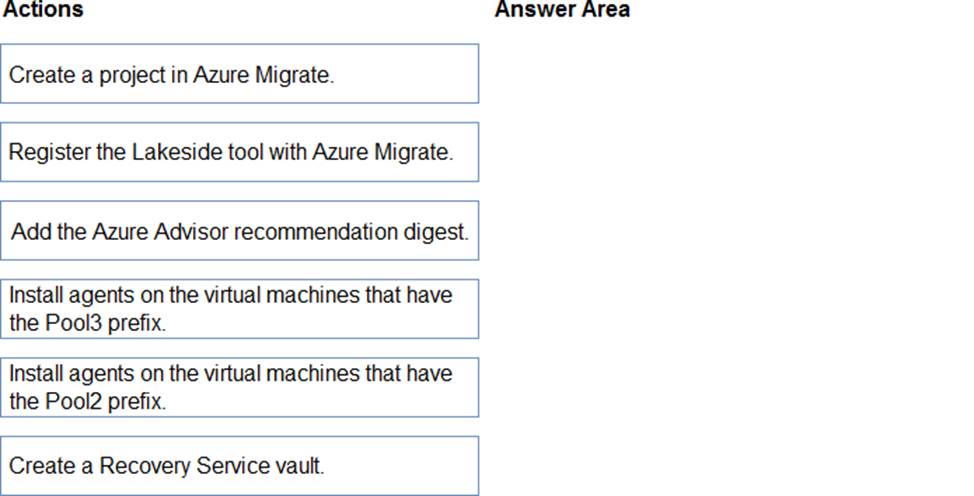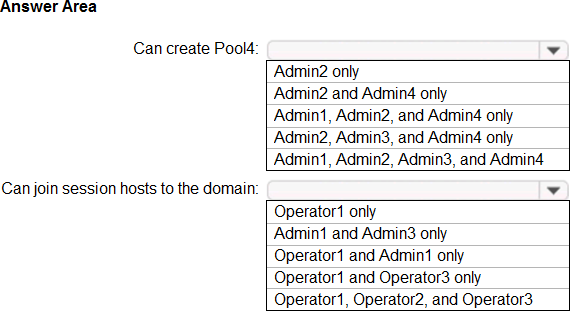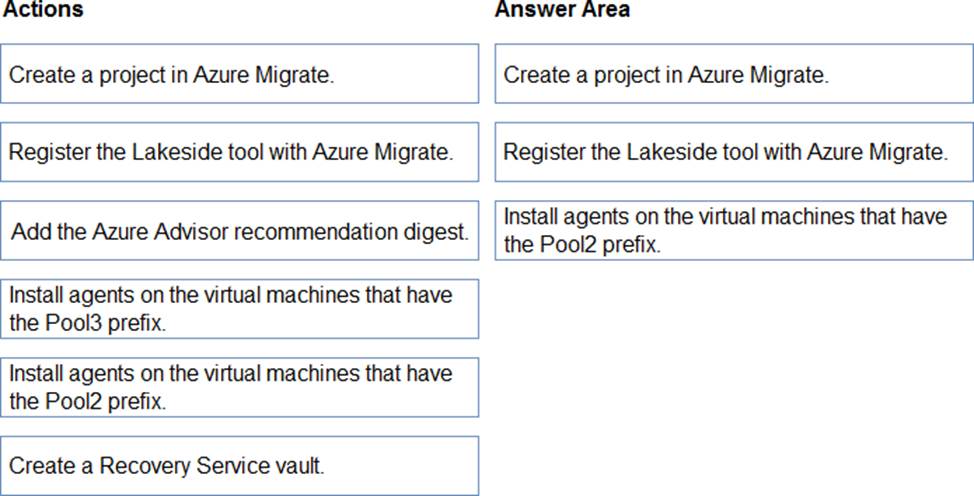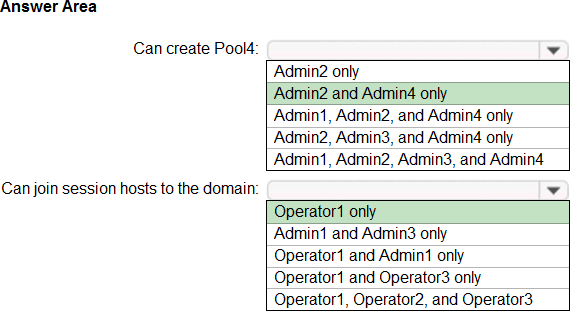Microsoft AZ-140 Configuring and Operating Windows Virtual Desktop on Microsoft Azure Online Training
Microsoft AZ-140 Online Training
The questions for AZ-140 were last updated at Nov 22,2024.
- Exam Code: AZ-140
- Exam Name: Configuring and Operating Windows Virtual Desktop on Microsoft Azure
- Certification Provider: Microsoft
- Latest update: Nov 22,2024
Topic 1, Contoso. Ltd
Case study
This is a case study. Case studies are not timed separately. You can use as much exam time as you would like to complete each case. However, there may be additional case studies and sections on this exam. You must manage your time to ensure that you are able to complete all questions included on this exam in the time provided.
To answer the questions included in a case study, you will need to reference information that is provided in the case study. Case studies might contain exhibits and other resources that provide more information about the scenario that is described in the case study. Each question is independent of the other questions in this case study.
At the end of this case study, a review screen will appear. This screen allows you to review your answers and to make changes before you move to the next section of the exam. After you begin a new section, you cannot return to this section.
To start the case study
To display the first question in this case study, click the Next button. Use the buttons in the left pane to explore the content of the case study before you answer the questions. Clicking these buttons displays information such as business requirements, existing environment, and problem statements. If the case study has an All Information tab, note that the information displayed is identical to the information displayed on the subsequent tabs. When you are ready to answer a question, click the Question button to return to the question.
Overview
Contoso, Ltd. is a law firm that has a main office in Montreal and branch offices in Paris and Seattle. The Seattle branch office opened recently.
Contoso has an Azure subscription and uses Microsoft 365.
Existing Infrastructure. Active Directory
The network contains an on-premises Active Directory domain named contoso.com and an Azure Active Directory (Azure AD) tenant. One of the domain controllers runs as an Azure virtual machine and connects to a virtual network named VNET1. All internal name resolution is provided by DNS server that run on the domain controllers.
The on-premises Active Directory domain contains the organizational units (OUs) shown in the following table.

The on-premises Active Directory domain contains the users shown in the following table.

The Azure AD tenant contains the cloud-only users shown in the following table.

Existing Infrastructure. Network Infrastructure
All the Azure virtual networks are peered. The on-premises network connects to the virtual networks.
All servers run Windows Server 2019. All laptops and desktop computers run Windows 10 Enterprise.
Since users often work on confidential documents, all the users use their computer as a client for connecting to Remote Desktop Services (RDS).
In the West US Azure region, you have the storage accounts shown in the following table.

Existing Infrastructure. Remote Desktop Infrastructure
Contoso has a Remote Desktop infrastructure shown in the following table.

Requirements. Planned Changes
Contoso plans to implement the following changes:
– Implement FSLogix profile containers for the Paris offices.
– Deploy a Windows Virtual Desktop host pool named Pool4.
– Migrate the RDS deployment in the Seattle office to Windows Virtual Desktop in the West US Azure region.
Requirements. Pool4 Configuration
Pool4 will have the following settings:
– Host pool type: Pooled
– Max session limit: 7
– Load balancing algorithm: Depth-first
– mages: Windows 10 Enterprise multi-session
– Virtual machine size: Standard D2s v3
– Name prefix: Pool4
– Number of VMs: 5
– Virtual network: VNET4
Requirements. Technical Requirements
Contoso identifies the following technical requirements:
– Before migrating the RDS deployment in the Seattle office, obtain the recommended deployment configuration based on the current RDS utilization.
– For the Windows Virtual Desktop deployment in the Montreal office, disable audio output in the device redirection settings.
– For the Windows Virtual Desktop deployment in the Seattle office, store the FSLogix profile containers in Azure Storage.
– Enable Operator2 to modify the RDP Properties of the Windows Virtual Desktop deployment in the Montreal office.
– From a server named Server1, convert the user profile clicks to the FSLogix profile containers.
– Ensure that the Pool1 virtual machines only run during business hours.
– Use the principle of least privilege.
DRAG DROP
You need to evaluate the RDS deployment in the Seattle office. The solution must meet the technical requirements.
Which three actions should you perform in sequence? To answer, move the appropriate actions from the list of actions to the answer area and arrange them in the correct order.

HOTSPOT
You are planning the deployment of Pool4.
What will be the maximum number of users that can connect to Pool4, and how many session hosts are needed to support five concurrent user sessions? To answer, select the appropriate options in the answer area. NOTE: Each correct selection is worth one point.

You plan to implement the FSLogix profile containers for the Seattle office.
Which storage account should you use?
- A . storage2
- B . storage4
- C . storage3
- D . storage1
Which role should you assign to Operator2 to meet the technical requirements?
- A . Desktop Virtualization Session Host Operator
- B . Desktop Virtualization Host Pool Contributor
- C . Desktop Virtualization User Session Operator
- D . Desktop Virtualization Contributor
HOTSPOT
Which users can create Pool4, and which users can join session hosts to the domain? To answer, select the appropriate options in the answer area. NOTE: Each correct selection is worth one point.

You need to configure the device redirection settings. The solution must meet the technical requirements.
Where should you configure the settings?
- A . Workspace1
- B . MontrealUsers
- C . Group1
- D . Pool1
You need to configure the virtual machines that have the Pool1 prefix. The solution must meet the
technical requirements.
What should you use?
- A . a Windows Virtual Desktop automation task
- B . Virtual machine auto-shutdown
- C . Service Health in Azure Monitor
- D . Azure Automation
Which setting should you modify for VNET4 before you can deploy Pool4?
- A . Service endpoints
- B . Address space
- C . DNS servers
- D . Access control (1AM)
- E . Peerings
Which three PowerShell modules should you install on Server1 to meet the technical requirements? Each correct answer presents part of the solution. NOTE: Each correct selection is worth one point.
- A . Pester
- B . RemoteDesktop
- C . ServerManager
- D . ActiveDirectory
- E . Hyper-V
Topic 2, Litware, Inc
Case study
This is a case study. Case studies are not timed separately. You can use as much exam time as you would like to complete each case. However, there may be additional case studies and sections on this exam. You must manage your time to ensure that you are able to complete all questions included on this exam in the time provided.
To answer the questions included in a case study, you will need to reference information that is provided in the case study. Case studies might contain exhibits and other resources that provide more information about the scenario that is described in the case study. Each question is independent of the other questions in this case study.
At the end of this case study, a review screen will appear. This screen allows you to review your answers and to make changes before you move to the next section of the exam. After you begin a new section, you cannot return to this section.
To start the case study
To display the first question in this case study, click the Next button. Use the buttons in the left pane to explore the content of the case study before you answer the questions. Clicking these buttons displays information such as business requirements, existing environment, and problem statements. If the case study has an All Information tab, note that the information displayed is identical to the information displayed on the subsequent tabs. When you are ready to answer a question, click the Question button to return to the question.
Overview
Litware, Inc. is a pharmaceutical company that has a main office in Boston, United States, and a remote office in Chennai, India.
Existing Environment. Identity Environment
The network contains an on-premises Active Directory domain named litware.com that syncs to an Azure Active Directory (Azure AD) tenant named litware.com.
The Azure AD tenant contains the users shown in the following table.

All users are registered for Azure Multi-Factor Authentication (MFA).
Existing Environment. Cloud Services
Litware has a Microsoft 365 E5 subscription associated to the Azure AD tenant. All users are assigned Microsoft 365 Enterprise E5 licenses.
Litware has an Azure subscription associated to the Azure AD tenant.
The subscription contains the resources shown in the following table.

Litware uses custom virtual machine images and custom scripts to automatically provision Azure virtual machines and join the virtual machines to the on-premises Active Directory domain.
Network and DNS
The offices connect to each other by using a WAN link. Each office connects directly to the internet.
All DNS queries for internet hosts are resolved by using DNS servers in the Boston office, which point to root servers on the internet. The Chennai office has caching-only DNS servers that forward queries to the DNS servers in the Boston office.
Requirements. Planned Changes
Litware plans to implement the following changes:
– Deploy Windows Virtual Desktop environments to the East US Azure region for the users in the Boston office and to the South India Azure region for the users in the Chennai office.
– Implement FSLogix profile containers.
– Optimize the custom virtual machine images for the Windows Virtual Desktop session hosts.
– Use PowerShell to automate the addition of virtual machines to the Windows Virtual Desktop host pools.
Requirements. Performance Requirements
Litware identifies the following performance requirements:
– Minimize network latency of the Windows Virtual Desktop connections from the Boston and Chennai offices.
– Minimize latency of the Windows Virtual Desktop host authentication in each Azure region.
– Minimize how long it takes to sign in to the Windows Virtual Desktop session hosts.
Requirements. Authentication Requirements
Litware identifies the following authentication requirements:
– Enforce Azure MFA when accessing Windows Virtual Desktop apps.
– Force users to reauthenticate if their Windows Virtual Desktop session lasts more than eight hours.
Requirements. Security Requirements
Litware identifies the following security requirements:
– Explicitly allow traffic between the Windows Virtual Desktop session hosts and Microsoft 365.
– Explicitly allow traffic between the Windows Virtual Desktop session hosts and the Windows Virtual Desktop infrastructure.
– Use built-in groups for delegation.
– Delegate the management of app groups to CloudAdmin1, including the ability to publish app groups to users and user groups.
– Grant Admin1 permissions to manage workspaces, including listing which apps are assigned to the app groups.
– Minimize administrative effort to manage network security.
– Use the principle of least privilege.
Requirements. Deployment Requirements
Litware identifies the following deployment requirements:
– Use PowerShell to generate the token used to add the virtual machines as session hosts to a Windows Virtual Desktop host pool.
– Minimize how long it takes to provision the Windows Virtual Desktop session hosts based on the custom virtual machine images.
– Whenever possible, preinstall agents and apps in the custom virtual machine images.
You need to recommend an authentication solution that meets the performance requirements.
Which two actions should you include in the recommendation? Each correct answer presents part of the solution. NOTE: Each correct selection is worth one point.
- A . Join all the session hosts to Azure AD.
- B . In each Azure region that will contain the Windows Virtual Desktop session hosts, create an Azure Active Directory Domain Service (Azure AD DS) managed domain.
- C . Deploy domain controllers for the on-premises Active Directory domain on Azure virtual machines.
- D . Deploy read-only domain controllers (RODCs) on Azure virtual machines.
- E . In each Azure region that will contain the Windows Virtual Desktop session hosts, create an Active Directory site.
Latest AZ-140 Dumps Valid Version with 53 Q&As
Latest And Valid Q&A | Instant Download | Once Fail, Full Refund




